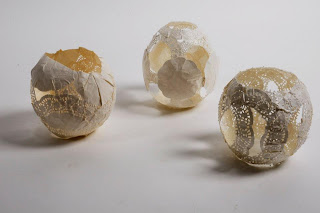Learning about sustainable design and it’s countless
possibilities has been an interesting and fascinating journey. It has taught me to be more aware of the type
of things I design and how they will affect the environment that they are
designed for. Through Sustainable design, I learned about the concept of
“Teds 10” a series of guidelines that I think should be practiced by every
designer including interior designers and architects.
In relation to my design practice, I was able to use what I had learned from sustainable design in a mini-project that involved reinventing a found object. I focused mainly on two concepts: minimizing waste and recycling/upcycling. The project involved either buying or finding an object and then reinventing it. For this project my group and I were able to recycle some wood and transform it into a coffee table, we had also found some used paper doilies and upcycled them into a lamp. This mini project taught me just how easy it is to design in a more environmentally friendly way but still be creative about it. Off course, this was a simple project but the concepts and ideas that I learned from this small project can still be mirrored and repeated for much larger ones.
In fact there are already ongoing architectural projects that can be deemed “sustainable” One example is the “Eden Project” which is a multiple greenhouse complex located in Cornwall. Open to the public, the Eden project is visited by people from all over the world to look at the greenhouses massive collection of plants from all over the world. Moreover the design of the Eden Project is as equally as impressive as its collection of plants. Dominated by two huge enclosures, the complex consists of adjoining domes. These domes consist of hundreds of hexagonal and pentagonal, inflated plastic cells which are then supported by steel frames. This smart design creates a natural biome within the domes and is what allows the environment inside to remain at a constant temperature and humidity. The complex also uses Green Tariff Electricity — the energy comes from one of the many wind turbines in Cornwall, which were among the first in Europe. As a result not only is the Eden project an amazing piece of architecture; it is also a sustainable one because of it’s ability to provide a natural environment for the plants it houses and it’s self sufficiency. Moreover the Eden project provides visitors with environmental education and awareness.
As a result I have gained a new
perspective on how we as designers can manipulate and guide our consumers to
buying and purchasing more environmentally friendly and sustainable things. With
global warming being an ever present threat to our daily life now is the time
to take action and heal the world. We can do this as designers as simply as
through our decision-making. We as
designers have the power and can control what goes into the market and what
doesn’t, by simply choosing to use a more eco-friendly material – like tree bark cloth or lyocell – we are
contributing to a better and cleaner earth. As a result we are able to make
sustainable products whether it be fashion-based products or interior based
products accessible to consumers. So
choose and design wisely!








